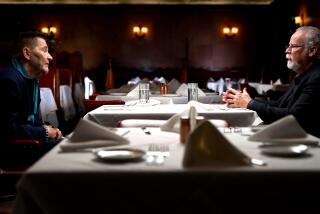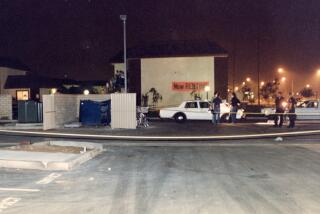DNA Query in O.C. Child Slaying
- Share via
It has yielded clues to Jimmy Hoffa’s disappearance, provided insight into Italian centenarians and identified victims of the World Trade Center terrorist attacks.
But only infrequently has mitochondrial DNA been used as evidence in a criminal trial, as Orange County prosecutors are seeking to do in the trial of the man accused of kidnapping and killing 5-year-old Samantha Runnion.
Samantha was abducted while playing outside her Stanton condominium complex on July 15, 2002. Her nude body was found the next day in the Santa Ana Mountains, miles from accused killer Alejandro Avila’s Lake Elsinore apartment. The case drew national attention as a tragic example of a parent’s worst nightmare.
Prosecutors would not comment on how crucial the disputed evidence is to their case or what other physical evidence links Avila and Samantha. But other lawyers said prosecutors would be unlikely to go through the ordeal of introducing mitochondrial DNA if the more typically used nuclear DNA was plentiful.
“Our traditional DNA techniques give us more discriminating information 99.9% of the time, so there’s no reason to do anything else,” said Los Angeles County prosecutor Lisa Kahn, forensic science advisor to Dist. Atty. Steve Cooley.
Police named Avila as a suspect soon after Samantha was killed. A frequent visitor to her neighborhood because his ex-girlfriend lived in the same complex, he had been acquitted of child molestation the year before and drove a car that matched a description given by one of Samantha’s playmates.
If the trial judge rules in January that the evidence that allegedly linking links Samantha and Avila can be used, it will be the third time that information gleaned from this kind of DNA has been used in California state courts -- a number that experts say belies how reliable the data are.
“To the judge or layperson, it may seem new, but it really isn’t,” Kahn said. “It’s a well-proven technique.”
Mitochondrial DNA was first admitted into evidence in California in a 2001 San Diego rape-murder case, and a second time in the recently completed Scott Peterson murder trial. In both cases, defense lawyers attacked mitochondrial DNA -- genetic information pulled from the energy-producing mitochondria outside a cell’s nucleus -- as unreliable and too easily contaminated.
The hearing to determine whether DNA scraped from under Samantha’s fingernails is expected to continue Jan. 10 for two weeks in Judge William R. Froeberg’s Santa Ana courtroom.
The DNA more typically used in courts is taken from a cell’s nucleus and can identify one person as the most likely source. But mitochondrial DNA can only rule out people as a source. Still, the data can drastically reduce the number of potential suspects -- providing more guidance than blood type, for example, but not as much as fingerprinting.
“Using mitochondrial DNA as evidence can make you more confident, showing you that it’s difficult to say a certain person wasn’t there,” said Doug Wallace, a DNA geneticist who heads the Center for Molecular and Mitochondrial Medicine at UC Irvine.
Mitochondrial DNA isn’t usually used when the other kind of DNA is present, but it becomes useful in situations where the sample is old, damaged or decayed by heat, scientists said.
Thus the assistance in tracing ancestry lines of Italian citizens older than 100, identifying victims of the 2001 World Trade Center attacks and linking samples of former Teamsters President Hoffa’s with hair strands found in a car police believe ferried him to his death.
Discovered by Caltech scientists in 1968, mitochondrial DNA can be used when nuclear DNA fails because there are thousands of pieces of it in each human cell, instead of the relatively small amount of genetic material found in the nucleus.
“Even in a very poor sample, like a spot of fluid that’s dried onto cloth,” Wallace said, “you are far more likely to recover mitochondrial DNA than nuclear DNA because there are so many more copies.”
Since mitochondrial DNA’s first use in the American court system -- a 1996 case in which a Tennessee man was convicted of the rape and murder of a 4-year-old girl -- nine states now permit it to be used during trial without first having a court hearing.
But in California, prosecutors first must persuade a judge to allow them to use the evidence.
Although defense attorneys typically object to the introduction of mitochondrial DNA, it has also been used in older cases to establish a convicted defendant’s innocence.
For example, an Idaho man convicted of murdering a 9-year-old girl spent 17 years on death row before the evidence cleared him in 2001. Shortly after being released from a maximum-security facility near Boise, Charles I. Fain told The Times that DNA was now his “best friend.”
The San Diego case and Peterson’s may provide the best window to the ongoing Orange County proceedings, since neither prosecutors nor Avila’s lawyers will discuss the evidence to be introduced or witnesses to testify.
Prosecutors in the case of Peterson, convicted of murdering his wife and their unborn child, were able to introduce mitochondrial DNA evidence linking a hair found on the defendant’s boat with a sample from his mother-in-law.
Peterson’s lawyers challenged the evidence as unreliable and laden with errors. Biology professor William Shields, of the State University of New York at Syracuse, testified that undetected mutations of mitochondrial DNA could skew results, and he said the FBI used a sample that was too small to detect contamination of the hair.
The FBI expert said the DNA extracted from the hair is found in 1 in 112 Caucasians, including Laci Peterson’s family. Shields said it is found in about 1 in 10 white people.
Shields, who did not return calls seeking comment, has testified in the majority of other hearings involving mitochondrial DNA. An expert considered the foremost in the field, Dr. Mitchell Holland, testified in the San Diego trial that Shields is a “professional complainer” and “not really an expert in the area,” according to a transcript.
When asked if any other scientist shared Shields’ contention that mitochondrial DNA mutates too much over time to be useful, Holland disagreed.
“And there’s other scientists that agree with his position, to your knowledge?” the prosecutor asked.
“I don’t know of any scientists that agree with that,” Holland replied.
Holland, who sources say will testify for the prosecution in Avila’s trial, is the lab director for Virginia-based Bode Technology Group.
“I’ve been involved with mitochondrial DNA now for over 10 years, and in my opinion, as long as it’s applied correctly, mitochondrial DNA testing is reliable,” he said in the San Diego trial. “It’s a valid method for use in criminal casework.”
Prosecutor Kahn said that once a California case -- most likely the San Diego one -- reaches the appellate level, such hearings as are being held in the Avila case will no longer be needed.
“Appellate endorsement can take years and years,” she said. “After that, though, it should be relatively simple.”
More to Read
Sign up for Essential California
The most important California stories and recommendations in your inbox every morning.
You may occasionally receive promotional content from the Los Angeles Times.













